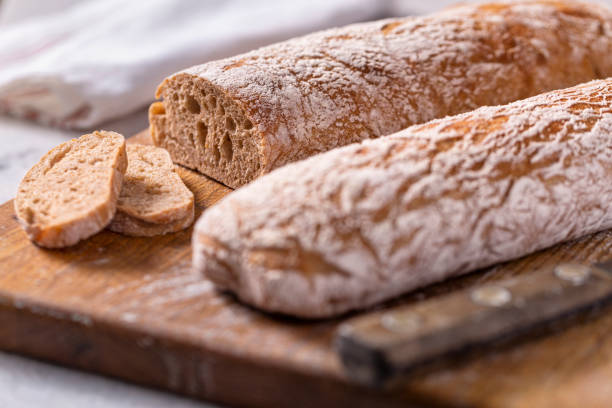If you’re itching to get your hands doughy and dive straight into bread-making, starting with ciabatta is a brilliant choice.
This guide is here to walk you through a foolproof ciabatta bread recipe, breaking down each step to make it super simple to follow.
I’ll show you how to mix, proof, shape, and bake your way to airy, crusty perfection.
You won’t need any fancy equipment or ingredients, just some basics from your kitchen and a bit of patience.
Let’s get baking and turn that flour into something to brag about!
Understand Ciabatta Bread
Ciabatta bread, with its crispy crust and soft, airy interior, is a staple of Italian cuisine that has won hearts worldwide, including in South Africa.
This rustic, artisanal bread might seem daunting to beginners, but with this guide, you’ll master the art of ciabatta baking in your own kitchen.
Ingredients
Before we dive into the process, let’s start with what you’ll need.
This recipe serves about 4-6 people, making two medium-sized loaves.
Ensure all your ingredients are measured accurately for the best results.
- Flour: 500g of strong white bread flour (preferably ’00’ flour if available)
- Water: 400ml of lukewarm water
- Yeast: 7g of instant yeast or 10g of fresh yeast
- Salt: 10g of sea salt or kosher salt
- Olive Oil: For greasing and drizzling
Equipment List
- Large mixing bowl
- Dough scraper or spatula
- Baking trays
- Parchment paper
- Kitchen scale
- Measuring jug
- Clean kitchen towel or plastic wrap
Step-by-Step Guide to Making Ciabatta Bread
Preparing the Dough
- Mixing Dry Ingredients: In your large mixing bowl, combine the flour and salt. If using instant yeast, mix it directly with the flour. For fresh yeast, dissolve it in a small part of the lukewarm water before adding it to the flour.
- Adding Water: Gradually add the lukewarm water to the dry mixture, stirring continuously until a sticky dough forms. Ciabatta dough is much wetter than other bread doughs, so don’t be alarmed by the consistency.
- First Proofing: Cover the bowl with a damp kitchen towel or plastic wrap. Let the dough rest in a warm place for about 1-2 hours, or until it doubles in size.
Shaping the Dough
- Preparation: Generously flour your work surface and hands. Ciabatta dough is sticky, and extra flour will prevent it from sticking to your hands and the surface.
- Gentle Handling: Turn the dough out onto the floured surface. Handle it gently to avoid deflating it too much. Shape it into a rough rectangle without overworking it.
- Dividing the Dough: Cut the rectangle into two equal parts to form two loaves. Be gentle to preserve the air bubbles inside the dough, which contribute to ciabatta’s characteristic texture.
Final Proofing
- Baking Trays: Line your baking trays with parchment paper and lightly flour the surface.
- Placing the Dough: Carefully transfer the shaped loaves onto the prepared trays. Cover them with a damp towel or lightly oiled plastic wrap.
- Resting Time: Allow the loaves to proof for another 45 minutes to 1 hour, until they’re puffy and have increased in size.
Baking Your Ciabatta
- Preheating the Oven: Preheat your oven to 220°C (430°F) at least 30 minutes before baking. The high temperature is crucial for achieving the perfect crust.
- Creating Steam: Place a shallow pan of water on the bottom rack of your oven. This will create steam during baking, which helps form a crispy crust.
- Baking: Bake the ciabatta loaves for 25-30 minutes or until they’re golden brown and sound hollow when tapped on the bottom.
- Cooling: Let the bread cool on a wire rack for at least an hour before slicing. This allows the crust to develop fully and the interior to set.
Tips for Perfect Ciabatta Every Time
- Hydration is Key: The high water content in ciabatta dough is what gives the bread its open crumb and light texture. Don’t be tempted to add more flour than the recipe calls for.
- Use a Scale: For baking, precision is crucial. Measuring your ingredients by weight rather than volume will yield more consistent and accurate results.
- Be Patient: The long proofing times allow the dough to develop its flavor and texture. Rushing this process will affect the quality of your bread.
- Handle with Care: When shaping your dough, be as gentle as possible to retain the air bubbles that contribute to ciabatta’s characteristic holes.
Baking is as much an art as it is a science. Each batch of ciabatta you bake will teach you something new, so don’t be afraid to experiment and make adjustments based on your observations and preferences.
Buon appetito!

